Ipswich Corporation Tramways
History
It is perhaps no surprise that Ipswich Corporation, which had acquired powers to construct a municipally owned electricity supply system as early as 1897, should subsequently decide to build and operate its own electric tramway system too. Powers to that end, as well as to purchase and convert the local horse-drawn tramway, which was owned by the Ipswich Tramway Company, were obtained in 1900. The corporation initially approached the company in 1899 to see whether it would be willing to sell them the tramway, but despite the ITCo's parlous financial situation, a price could not be agreed, the corporation eventually resorting to a compulsory purchase order, with the price set by arbitration, all of which needless to say, took time.
The corporation eventually took possession of the tramway on the 1st November 1901, operating it for 16 months before closing it for reconstruction — and also to put a stop the losses its operation was incurring — the last horse tram running on the 6th June 1903. For some reason, construction of the new system seems to have been a rather protracted affair, the first public service on the new 3ft 6ins-gauge, overhead electric tramway not commencing until the 23rd November 1903, almost two years after the corporation had bought the ITCo out.
The system, which reached its maximum size in May 1904, was 10.82 miles long, with lines radiating from a west-to-east backbone from Barrack Square through Cornhill to Majors Corner. Lines ran: westwards along Bramford Rd to the Great Eastern Railway overbridge; northwestwards along Norwich Rd to Whitton; eastwards along Spring Rd to Lattice Barn, with a branch running southwards to Derby Rd Station; southwestwards along Fore St and Felixstowe Rd to the Royal Oak; southwards along Queen St and Wherstead Rd to Bourne Bridge, with a branch along Bath St to the Quay; and lastly, a loop line running westwards from the Bourne Bridge line at Burrell Corner to the main railway station, where it turned northeastwards before splitting, one line running along Princes St to Cornhill and the other along Portman Rd to Barrack Square, the latter with a short branch leading westwards along Constantine Rd to the depot.
Like most tramway systems, Ipswich's suffered during the Great War from loss of staff (and skills), severe restrictions on the purchase of spares, new track or vehicles, as well as an inability to do anything other than the absolute minimum of maintenance. The track also suffered badly from greatly increased road traffic driven by the war economy, many of the heavily laden vehicles having iron-shod wheels. As a result, the system emerged from the conflict in very run-down condition, and whilst repairs were carried out, it quickly became clear that the corporation were looking for a less financially onerous solution than complete renewal of the tramway system. Although there was agitation within the town to look at motorbuses, the corporation favoured trolleybuses, a not uncommon situation where the tramway owners, be it a corporation or a company, also owned the electricity generation and supply infrastructure. A change of manager in 1921 also brought new ideas, which doubtless influenced the council's thinking.
Although the first tramway closure — the Bath St branch — had taken place in 1917 to enable its track to be used elsewhere, the first major line closure came on the 2nd September 1923 when the trams were withdrawn on the Cornhill to Station route to facilitate a trial involving on-loan trolleybuses, a temporary expedient which in fact became permanent.
The corporation's interest in trolleybuses elicited an offer by the local motorbus operator — Eastern Counties Road Car Company Limited — to buy the corporation out and to operate the entire system with motorbuses. This eventually led to a ratepayer referendum in 1925, which endorsed retention (and expansion) of the corporation trolleybuses, and by a fairly large margin, the outcome no doubt influenced by the fact that two local firms — Garrett's and Ransomes — built trolleybuses.
Following the referendum, the corporation applied for powers to abandon the tramway completely and replace the services with trolleybuses, Royal Assent being granted on the 7th August 1925. The end of the tramway was now in sight, most of the lines being abandoned between May and July 1926, the last tram of all running on the 26th July 1926, a relatively early closure date for a municipal tramway system.
Uniforms
Ipswich Corporation took over the horse tram operations of the erstwhile Ipswich Tramway Company in November 1901, and continued to run horse-drawn services up until June 1903. Photographs which are incontestably from this era appear not to have survived, so it is currently impossible to state whether the corporation chose to issue uniforms to the men working these services, or whether it merely continued the policy of its predecessor, which was to have drivers and conductors wear informal but smart attire.
Staff working the new electric services were issued with double-breasted, 'lancer-style' tunics with five pairs of buttons, bearing the system title and Ipswich arms (see link) and upright collars; the latter bore an employee number on the bearer's left-hand side (in metal numerals) and system initials on the right-hand side (in individual metal letters). Caps were in a military style with a tensioned crown (top) and bore 'off-the-shelf' script-lettering grade badges, either Motorman or Conductor. Badges and buttons were almost certainly brass. The uniforms remained unchanged right through to the closure of the system in 1926.
Tramcar crews were also issued with double-breasted greatcoats with five pairs of buttons, epaulettes (with button fasteners) and high, fold-over collars; the latter do not appear to have carried any insignia.
Inspectors initially wore typical tramway inspector garb, i.e., single-breasted jackets edged in a finer material than the main jacket, with hidden buttons (or more likely a hook and eye affair), and upright collars; the latter almost certainly bore Inspector in embroidered script lettering on both sides. Headgear took the form of a kepi-style cap which bore the grade — Inspector — again probably in embroidered script lettering (on a hat band). At some point prior to the Great War, the jackets were changed to a rather distinctive single-breasted design with plain buttons, two breast pockets (with button closures), pleats, epaulettes (with button fasteners) and upright collars; the latter definitely bore embroidered system initials — ICT — on the bearer's right-hand side, and in all probability on the left-hand side too. Caps were probably changed at the same time to a military style with a tensioned crown; these bore the grade — Inspector — in embroidered script-lettering, on a hat band.
In common with the vast majority of UK tramway systems, Ipswich employed women during the Great War, as conductresses, to replace male staff lost to the armed services. These ladies were issued with long, tailored, single-breasted jackets with two large hip-level pockets, pleats, a waist belt and high, fold-over collars; the latter bore a staff number on the bearer's left-hand side (in individual brass numerals) and system initials — 'I C T' — on the right-hand side (in brass letters). The style of the uniform jacket was subtly altered at some point through the addition of a pocket on the bearer's right breast (with button closure) and epaulettes (with button fasteners). Summer headgear took the form of a straw bonnet upon which a script-lettering grade badge — Conductor — was worn; this was mounted on a hat band. In winter, waterproof bonnets were worn; these carried the usual brass, script-lettering grade badge.
Further reading
For a pictorial history of Ipswich's tramways, see: 'Ipswich Tramways' by Colin Barker; The Middleton Press (2009).
Images
Motormen and conductors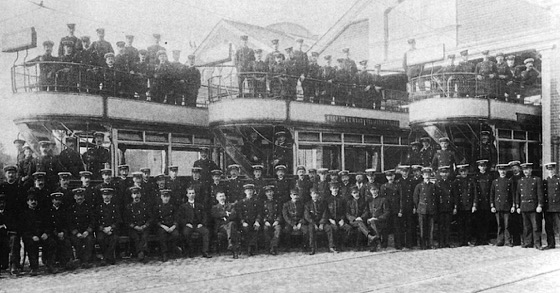
Probably the entire uniformed tramway staff assembled at Constantine Rd depot — photo undated, but possibly taken to mark the inauguration of services in 1903. Photo courtesy of the Tramways and Light Railway Society, with thanks to David Voice.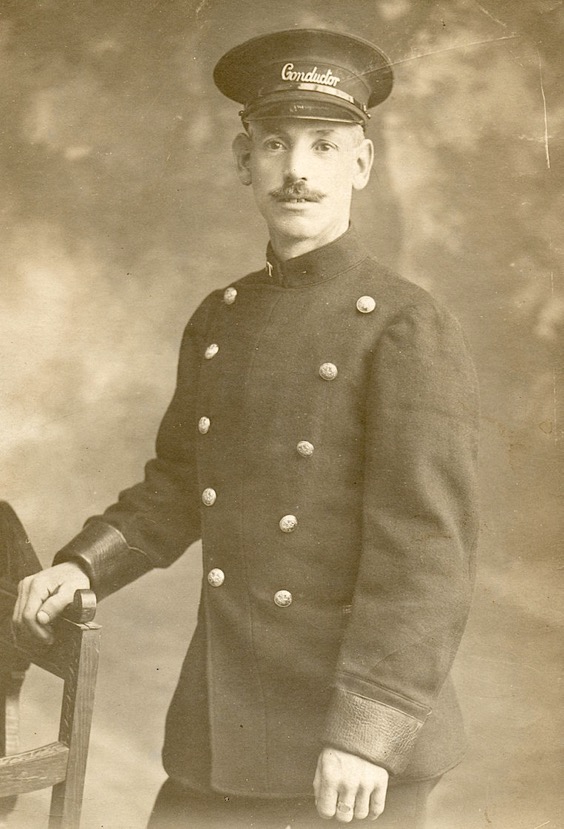
A fine studio portrait of an Ipswich Corporation Tramways conductor — photo undated, but very probably taken around the time electric services began (1903). His left-hand collar is plain, suggesting that employee numbers had not yet been issued. Author's Collection.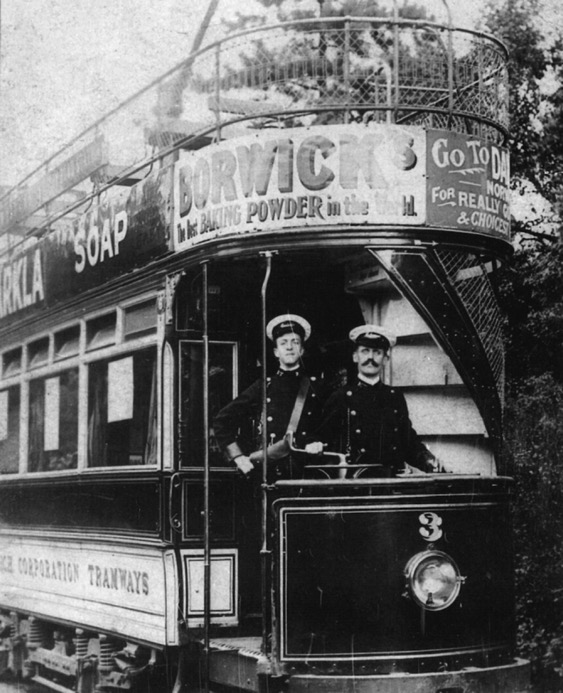
The crew of Tramcar No 3 pictured at what may be Derby Road Station, with a service for Norwich Rd and Derby Rd — photo undated, but probably mid-to-late Edwardian. Photo courtesy of the Tramways and Light Railway Society, with thanks to David Voice.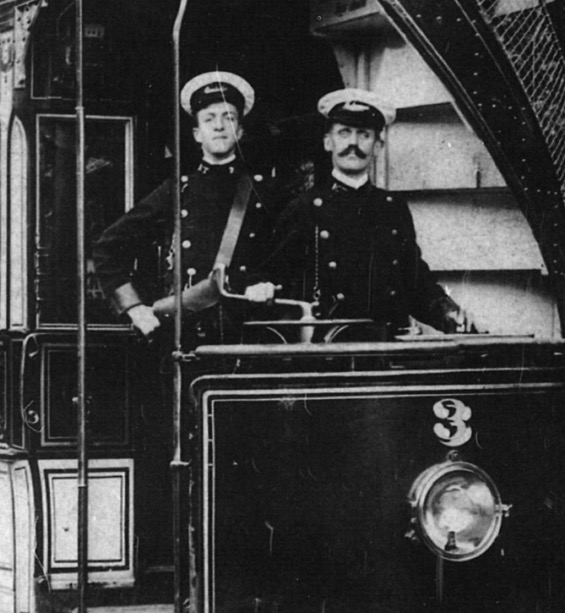
A blow-up of the above photo showing the conductor and motorman. 
General pattern script-lettering cap badges — Motorman and Conductor — of the type used by Ipswich Corporation Tramways; brass. Author's Collection.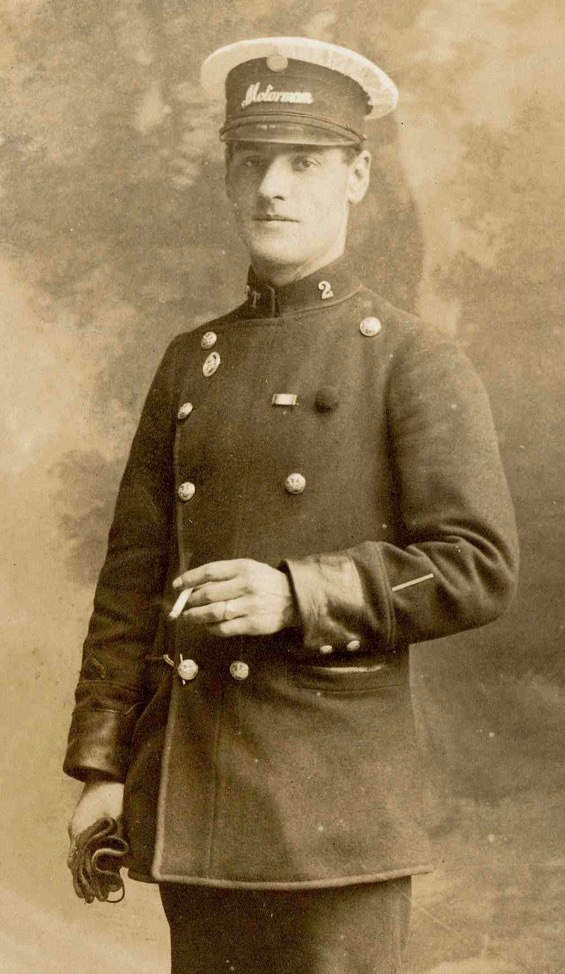
ICT motorman (Employee No 2) — from a photographic postcard dated 4th July 1918. The subject was almost certainly discharged from the army after being wounded as he has a Silver War Badge on his right breast, as well as a medal ribbon on his left. The small round badge on his cap is probably a personal adornment, perhaps military in origin. The message on the back of the postcard reads “To George Knight with my very best and sincerest wishes and the best of luck. From your old and sincere Pal, Alex, Ipswich 4/7/18”.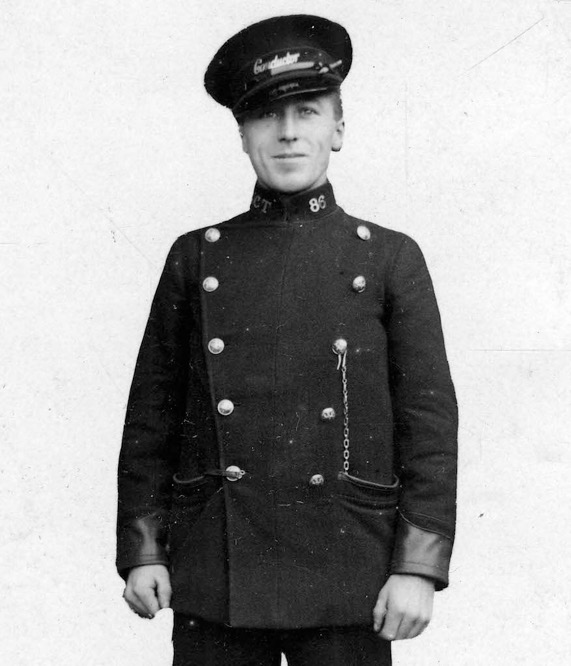
ICT Employee Number No 86, Conductor Terry Maile — photo undated, but probably taken in the 1920s. The text on the reverse of the photo reads “Mr. Terry Maile of 55, Ranelagh Road, Ipswich in the old double-breasted uniform as was worn for many years on the old trams and trolleys, up to the present day open neck tunic being introduced.” With thanks to Ipswich Transport Museum (see link).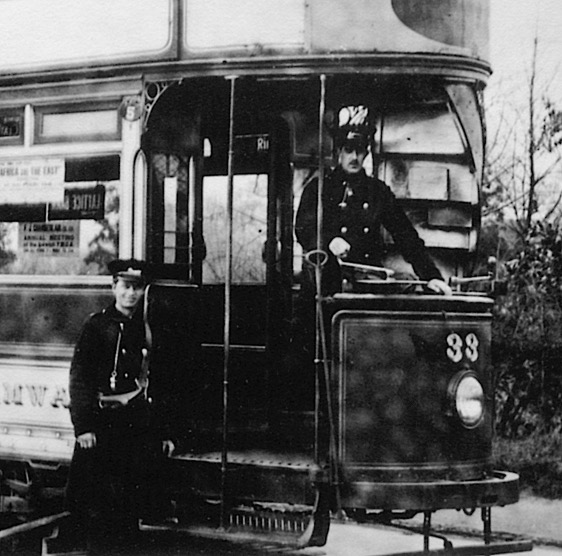
The crew of Tramcar No 33 pose for the cameraman at what may be Lattice Barn with a Route 3 service (Lattice Barn to Ipswich Railway Station) — photo undated, but certainly taken after 1922 when route indicators were introduced. Both men are wearing double-breasted greatcoats. Photo courtesy of the Tramways and Light Railway Society, with thanks to David Voice.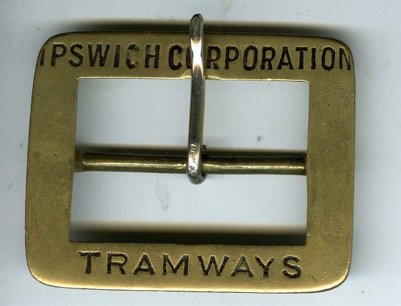
ICT cash bag buckle — brass. Photo courtesy of Ipswich Transport Museum (see link).
Senior staff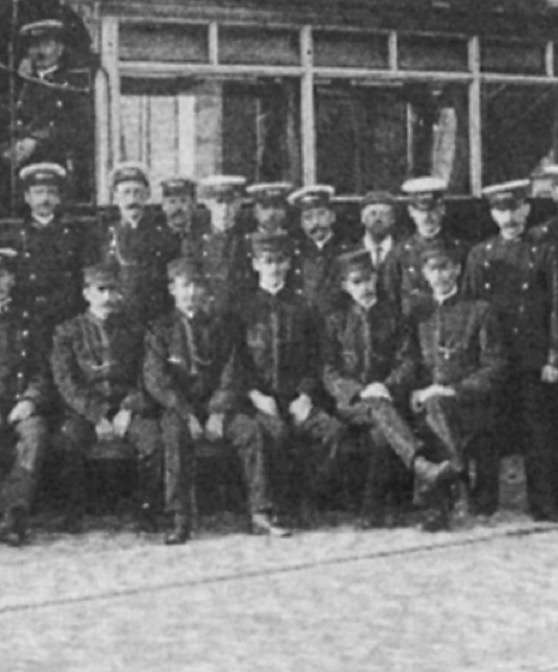
A blow-up of the depot photo above — probably taken in 1903, and showing a group of inspectors (front row). They are wearing typical tramway 'inspector' garb, with kepi-style caps.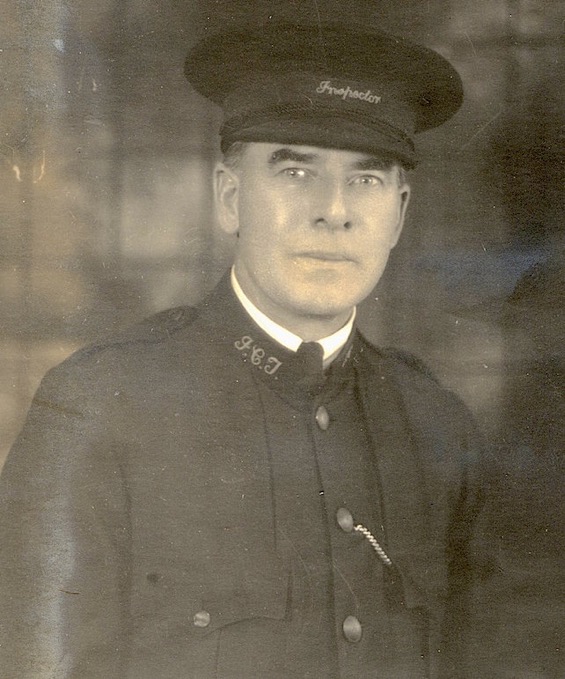
An individual who is possibly an Ipswich Corporation Tramways inspector — photo undated, but probably taken in the 1920s or 1930s (the latter of course post-dating the demise of the tramway). The uniform is quite an unusual design, and has the distinctive breast pleats seen in other photos, both of inspectors and Great War conductresses (see above), so the attribution seems reasonably sound. Author's Collection.
Female staff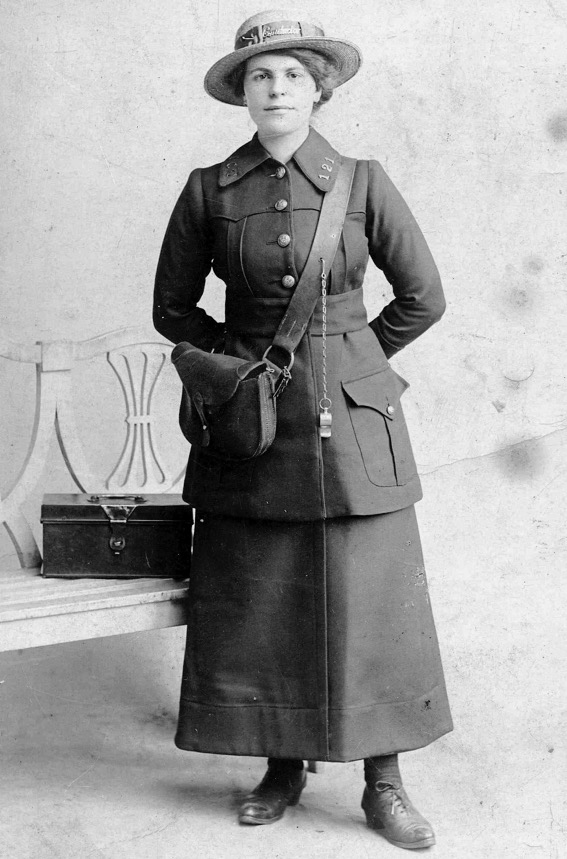
Conductress Mary Ann Lambert (Employee No 121) — photo undated, but almost certainly taken during the Great War. Miss Lambert was born in Lavenham, Suffolk on 13th July 1892, her family later moving to 38 Friars St, Ipswich. With thanks to Ipswich Transport Museum (see link).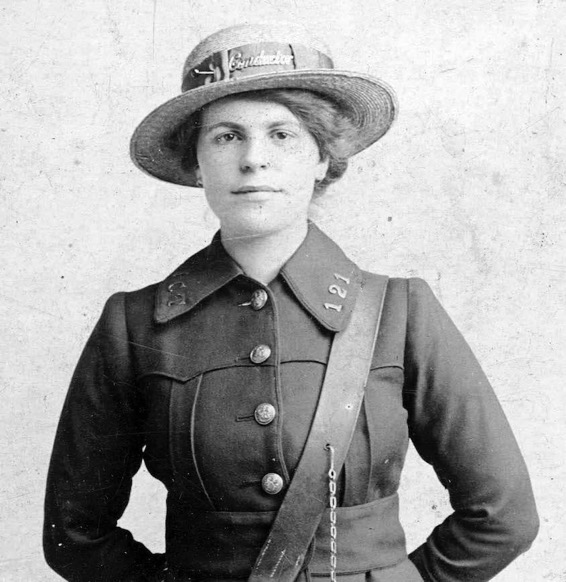
A blow-up of the above photo, which is so sharp, even the buttons can be positively identified.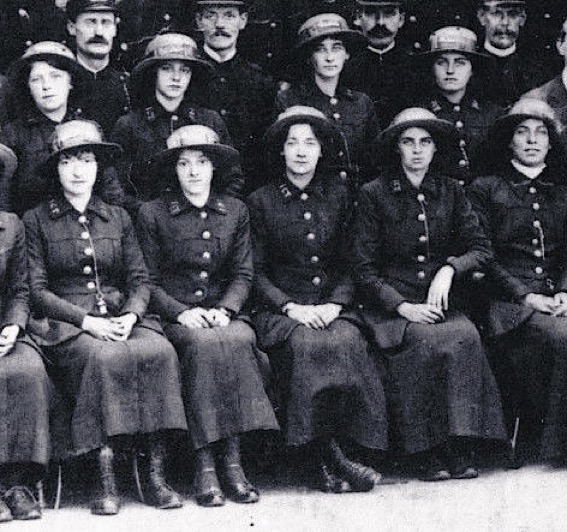
A group of Ipswich Corporation Tramways Great War conductresses at Constantine Rd depot.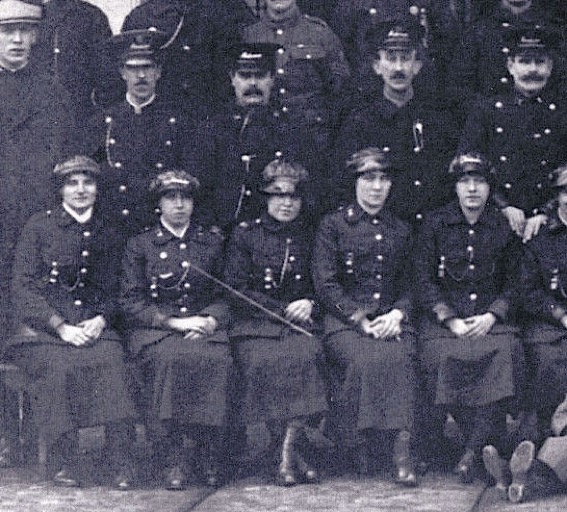
Another Constantine Rd depot shot — photo undated, but almost certainly taken during the Great War. Although similar to the uniform in the preceding photos, the jacket now has a pocket on the bearer's right breast, as well as epaulettes. The photograph was presumably taken in winter, as the hats are all waterproof bonnets.